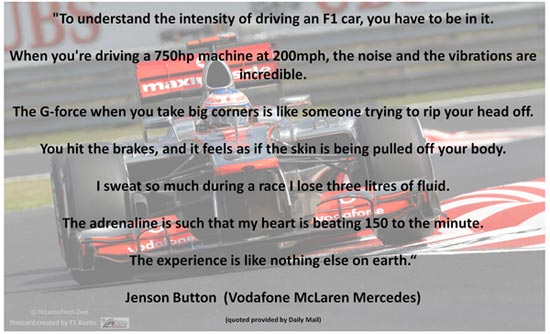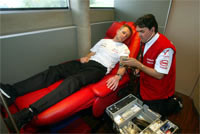The fitness required for modern F1 race cars (and Shifter Karts!) is much higher than the general public realizes. Word Racing owner, Randy Word, is an avid fitness guru and gathered the below information to illustrate. A short background on Randy - he is a 10 time bicycle road racing State Champion medalist and twice National podium. He also road raced motorcycles at a semi-pro level, won regional Shifter Kart championship and runs 10k and 1/2 marathon races in his spare time!

3 G's requires extreme fitness
Today's modern racing karts can exert corning forces in excess of 3 G's! After only 15 minutes on the track, it's not uncommon for drivers to be soaked with sweat. Those new to karting will experience difficulty holding their head up straight after several laps, and "arm pump". It's also a serious workout for the "core" muscles, and requires complete focus 100% of the time. The host of Northwest Sports TV said Karting was the hardest sport he's ever tried, both physically and mentally.
Drivers use rib protectors to combat rib injury, but physical fitness is required to endure the g-force and maintain 100% concentration. Randy trains with traditional core exercises, weight lifting, and cycling. Watch this short video that demonstrates what g-force feels like, with a bowling ball attached to a helmet!
Here's a short video clip, from ESPN Sport Science, showing Indy race driver setting a new reaction time record: http://espn.go.com/video/clip?id=9310395 , and another one featuring Will Power demonstrating the fitness and reaction times needed at 230 mph - http://youtu.be/JrzSqZZ80h8
Driver Fitness with Josef Newgarden
Article from F1 Technical explaining the fitness required for racing - reprinted with permission © 1999- 2024 F1Technical.net
Imagine driving the fastest cars on earth, imagine the strain this puts on your body. Fitter than football players and leaner than most athletes: racing car drivers possess some of the most finely tuned bodies on earth.
Medical studies consent. During a race a driver must remain calm, focused and in constant communication with the technical team while perfectly maneuvering a highly complex vehicle around an unfamiliar track alongside competitors, traveling at speeds over 300 kilometers/hour.
All this in an environment where one wrong move can cost lives calls for a sportsman at the very peak of physical and mental strength. Fifteen years ago drivers achieved this by visiting the gym twice a week. These days they know better.

The heart
A human being has a resting heart rate of around 60 beats/minute, rising to around 150 during a run on the treadmill. David Coulthard (Red Bull Racing Team) has a resting heart rate of 40 beats/minute, rising to 198 beats/minute during a two hour race, a figure - approximately the same as that of a marathon runner crossing the finishing line - which initially stunned medical researchers.

Dr Riccardo Ceccarelli, from Italian sports medicine clinic 'Formula Medicine' and of the Panasonic Toyota Racing Team, explains why a high speed drive can be as challenging as a 26 mile run.
Dr. Riccardo Ceccarelli "The difference is one of mental stress. There is no sport that demands such intense concentration. A huge amount of adrenaline is being pumped, and this - as well as the physical strain - causes the high heart rate."
The body's ability to cope with such extremes is a result of intensive workout and so drivers undergo cardiovascular exercise for up to four hours a day: jogging, cycling, rollerblading.... This also helps to keep weight in check - a driver such as David Coulthard maintain a body fat ratio of 7%, similar to that of a runner at the start of a race.
The neck
Ceccarelli "I know of no other sport that places such big demands on the neck muscles. A head and F1 helmet together weigh about 6kg. Add about 4G-Force as experienced when cornering in a Grand Prix, and the neck has to support 24kg."
The neck is a driver's most important muscle. During training, large elastic bands are used to simulate the demands of high G-Force. Drivers also incorporate resistance work into their exercise regime - rowing and weight lifting. But they have to be careful not to go overboard: Formula One cockpits are very small and don't accommodate someone with the physique of a weight lifter.
Diet
Formula One drivers eat much like track and field athletes - carefully regulating their carbohydrate and protein intake. In the lead up to a big race they'll gorge on carbs - pasta and bread - for energy.
Immediately before the race and sometimes throughout, drivers absorb huge amounts of water. Failure to do so could bring on dehydration through sweating - the extreme heat found in a Formula One cockpit means drivers can sweat off up to 3 kg of their body weight during the course of a race.
Mental health
Formula One drivers don't just take care of their bodies, they look after their mental health too. Many of the F1 Teams work with sports psychologists to ensure that a driver can exert unwavering mind control during a race. Methods include reviewing track maps, visualizing a route and a perfect lap, in order for the driver to feel he has driven the course many times before he even arrives there.
Drivers also learn breathing techniques to stay calm at crucial moments, and techniques for shutting out the outside world - a driver getting into a car surrounded by a medical team, technical staff and thousands of fans and members of the press may use the click of the seat belt as a trigger to block these distractions and get to work.
Formula Medicine
Formula Medicine is a team leader in medical and athletic assistance for motor-racing drivers. Since 1994, Formula Medicine, has co-operated with more than 250 racing drivers, including 36 Formula One drivers. The staff is made up of doctors, athletic trainers and physiotherapists, led by Dr. Riccardo Ceccarelli, who has been working in Formula One since 1989.
Medical check up at "Centro Medico Don Bosco" Every driver has to go through a complete medical check-up before starting the athletic programme. The medical examinations are organized by Formula Medicine in co-operation with Centro Medico Don Bosco, a modern diagnostic centre which can provide
fast consultations in "day hospital" thanks to the collaboration of more than 60 specialists.
Athletic evaluation and training in Formula Medicine
Formula Medicine has a modern gym, equipped by Technogym, available exclusively for motor-racing drivers. Formula Medicine trainers also support the drivers in many outdoor activities: kayaking on lake, cycling, jogging, swimming, tennis,...
Panasonic Toyota Racing works close together with Formula Medicine. The F1 Team entrusts Formula Medicine with the following activities:
The man behind Formula Medicine is Dr. Riccardo Ceccarelli. Ceccarelli is born in Viareggio, Italy, on May 27, 1960. He is Doctor of Medicine and Surgery, he's specialized in Sports Medicine and highly experienced in physiotherapy and postural diseases.
He has experience in Formula One since 1989. He worked with the March Leyton-House, Scuderia Italia, Ferrari, Minardi, Toyota Motorsport Team.
Article courtesy of F1 Technical. Reprinted with permission. Copyright © 2005
"But it's really tough on these guys. When you see Tony Kanaan not be able to stand up to do a television interview after a race, that should tell you something. Nobody's more fit than Tony." - Bobby Rahal, regarding 2012 Indy Car Mid-Ohio race (run without any yellow caution periods).
Interested in getting started in the sport? Here's an article of what it takes to get started in karting - kart racing